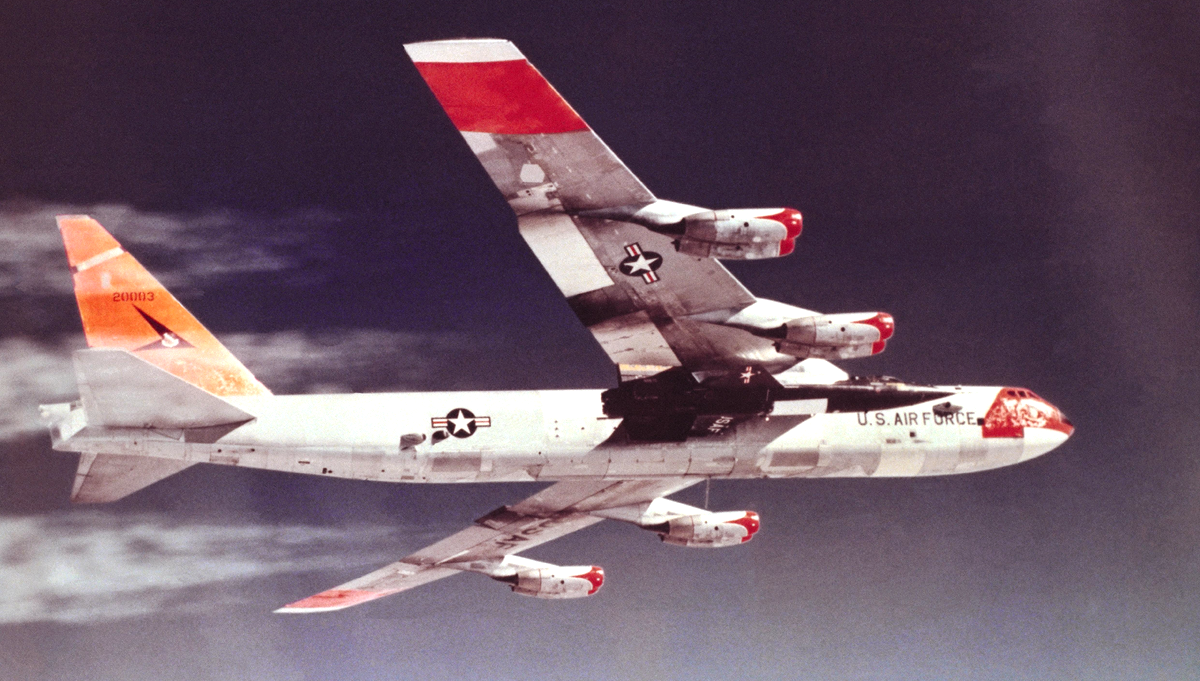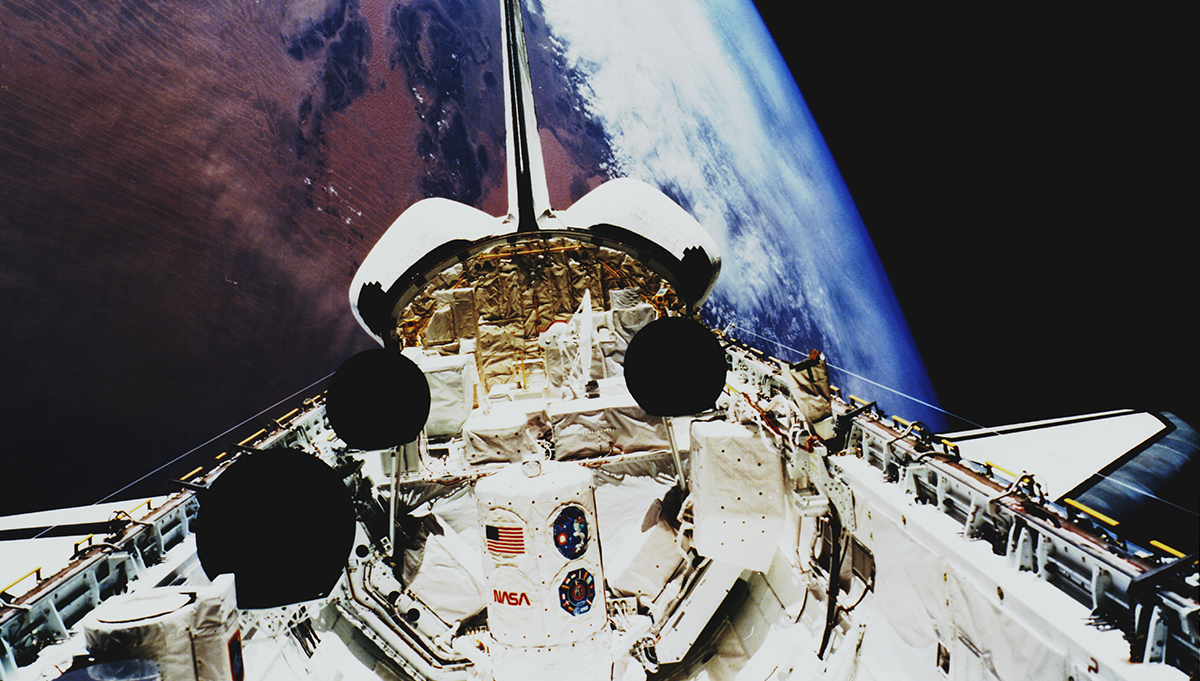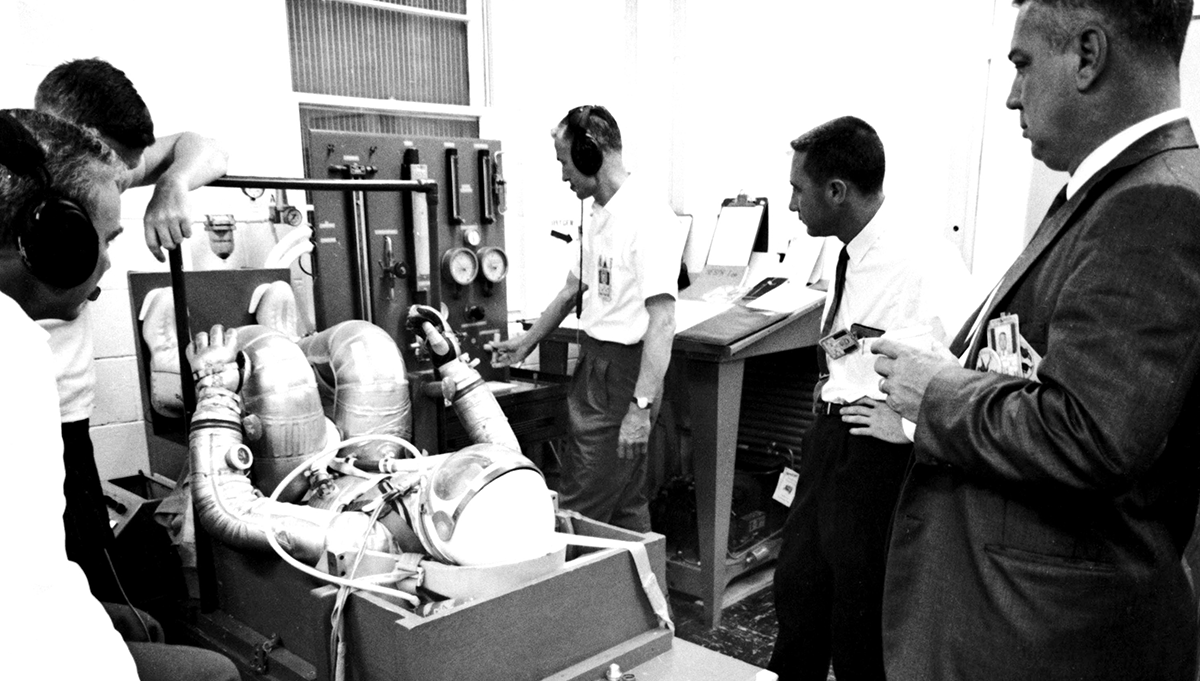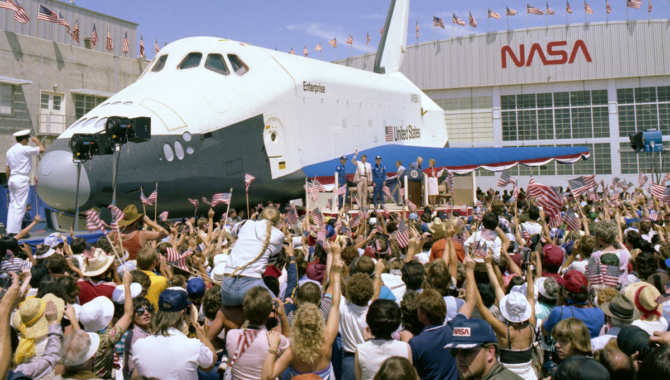
President Ronald Reagan (tan suit) waves from the podium as thousands of spectators cheer. More than half a million people gathered to watch Space Shuttle Columbia touch down following STS-4. The prototype Space Shuttle Enterprise is behind Reagan.
Photo Credit: NASA
Columbia impresses Apollo veteran Ken Mattingly.
On June 27, 1982, NASA launched Space Shuttle Columbia on STS-4, the final orbital research and development flight of the program. Apollo veteran Thomas K. “Ken” Mattingly, II, was in the commander’s seat. To his right was pilot Henry “Hank” Hartsfield, Jr., making his first spaceflight.
Astronauts later in the program would characterize the ride into space on the shuttle as “loud,” “forceful,” “exhilarating,” and “overwhelming.” What stood out to Mattingly, who had the launch of Apollo 16 to compare it with, was how smooth it was.
“…Launch in Apollo was really dramatic. It feels just like it sounds. You hear this staccato cracking and all of that from the engines. Man, inside it’s the same thing. It’s shaking and banging and pushing hard, and there is no doubt that something really gigantic is going on,” Mattingly recalled in an oral history.
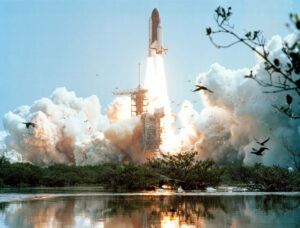
Columbia launches on June 27, 1982, on STS-4, the final orbital research and development flight of the new space shuttle program.
Photo Credit: NASA
“The Shuttle would lift off, it’s not noisy, it doesn’t shake. It just goes. It was a totally different experience,” Mattingly added, noting Columbia’s large windows, comfortable cockpit, and spacious mid-deck.
STS-4, like the three missions before it, was scheduled to verify the performance of the orbiter, solid rocket boosters, and external tank, and to validate some of the shuttle’s capabilities and characteristics for future missions. Some of these tests involved Columbia’s thermal properties in space. Mattingly and Hartsfield would orient the shuttle with one side facing the Sun, then reorient it so that side was facing out into the solar system and collect data about how the surfaces heated and cooled.
It was a long first day in space. Mattingly—one of seven people to orbit the Moon alone—stayed awake long after Hartsfield had gone to the mid-deck for sleep, looking out Columbia’s windows into space. “Flying around the Earth is just so spectacular. I don’t care how long you’re up there, I can’t imagine anyone ever getting tired of it. It’s just beautiful, and the orbiter, with these big windows… It is just wonderful.”
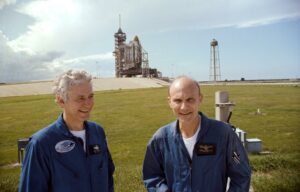
Astronauts Thomas K. “Ken” Mattingly, II, right, and Henry “Hank” Hartsfield, Jr., pose for news photographers in front of the Space Shuttle vehicle during break in the countdown demonstration test (CDDT) for STS-4.
Photo Credit: NASA
Later in the mission, Mattingly tested the new Extravehicular Mobility Unit that astronauts would wear on spacewalks throughout the shuttle era. There was no spacewalk scheduled for STS-4, but Mattingly had trained for one in the event an unexpected issue with the new spacecraft required the astronauts to venture out of the vehicle to make a repair. Mattingly practiced putting the suit on in the shuttle’s airlock and taking it off.
The mission was the first time the shuttle program carried a classified experiment from the U.S. Department of Defense. Officials on the ground walked the astronauts through the experiment by directing them through a coded checklist.
STS-4 returned to Earth on July 4, 1982. Mattingly had planned to turn control over to Hartsfield for a time on the descent but developed one of the worst cases of vertigo in his career and focused on the controls to combat the vestibular sensation. By the time it lifted, Columbia was on the glide slope to landing.
Landing the shuttle was a delicate balancing act, Mattingly said. Landing too fast would stress the tires. Landing too slow risked having the nose hang in the air too long, and then stress the fuselage when it came down. “So, you really need to get there and get the nose down,” he recalled.
“So, [Hartsfield is] calling off air speeds and altitude, and I’m just staring at the horizon and I’m hawking it, and I have no idea what it’s going to feel like to land. … Then finally Hank says, ‘You’d better put the nose down,’ ” Mattingly recalled. Certain they were still in the air but not far from the ground, Mattingly put the nose down. “Sure enough, we were on the ground [already] and neither one of us knew it. I’ve never been able to do that again in any airplane. Never did it before.”
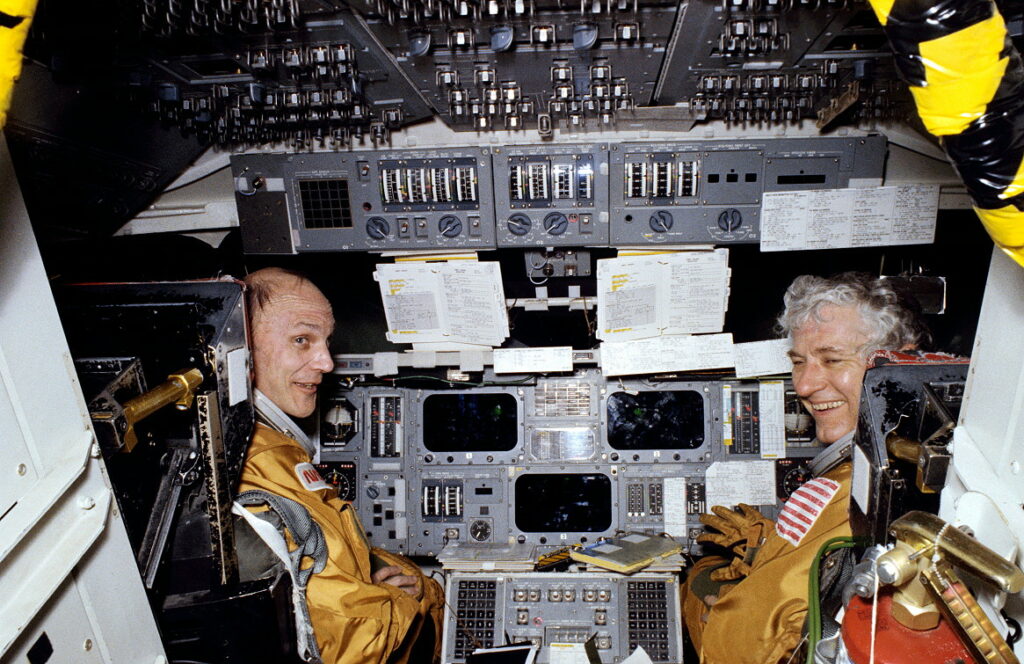
Astronauts Thomas K. “Ken” Mattingly II, (left) and Henry “Hank” Hartsfield, Jr., STS-4 commander and pilot, respectively, get in some training time in the motion base Shuttle Mission Simulator (SMS) at the Johnson Space Center’s Mission Simulations and Training Facility.
Photo Credit: NASA
More than half a million people were gathered at Edwards Air Force Base to mark the end of that phase of the space shuttle program. President Ronald Reagan and First Lady Nancy Reagan joined Mattingly and Hartsfield for a walkaround inspection of Columbia. Later, the president thanked the astronauts for giving “the American people a Fourth of July present to remember.”
The mission added to the space shuttle’s rave reviews as the program was about to move into a cadence of regular missions. “…This thing worked, and I just couldn’t get over the fact… People [who] I knew, [who] were friends had built and conceived this whole thing, and it works. It’s just magic. It does all of these things that we dreamed of,” Mattingly said.
Visit APPEL KS’s Shuttle Era Resources Page to learn more about STS-4 and the 134 other shuttle missions that deployed key satellites, enabled important new research, and were instrumental in construction of the International Space Station.






